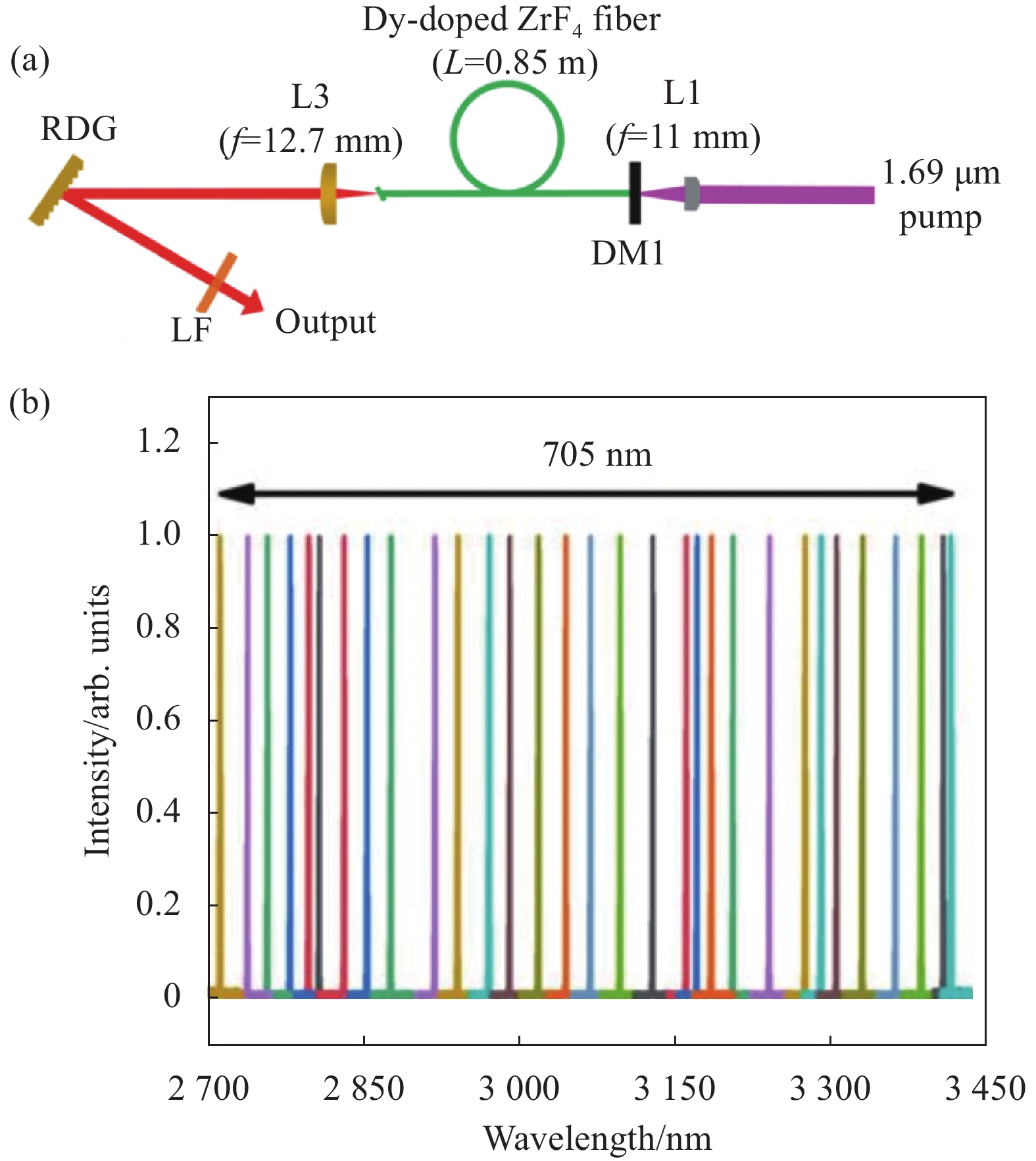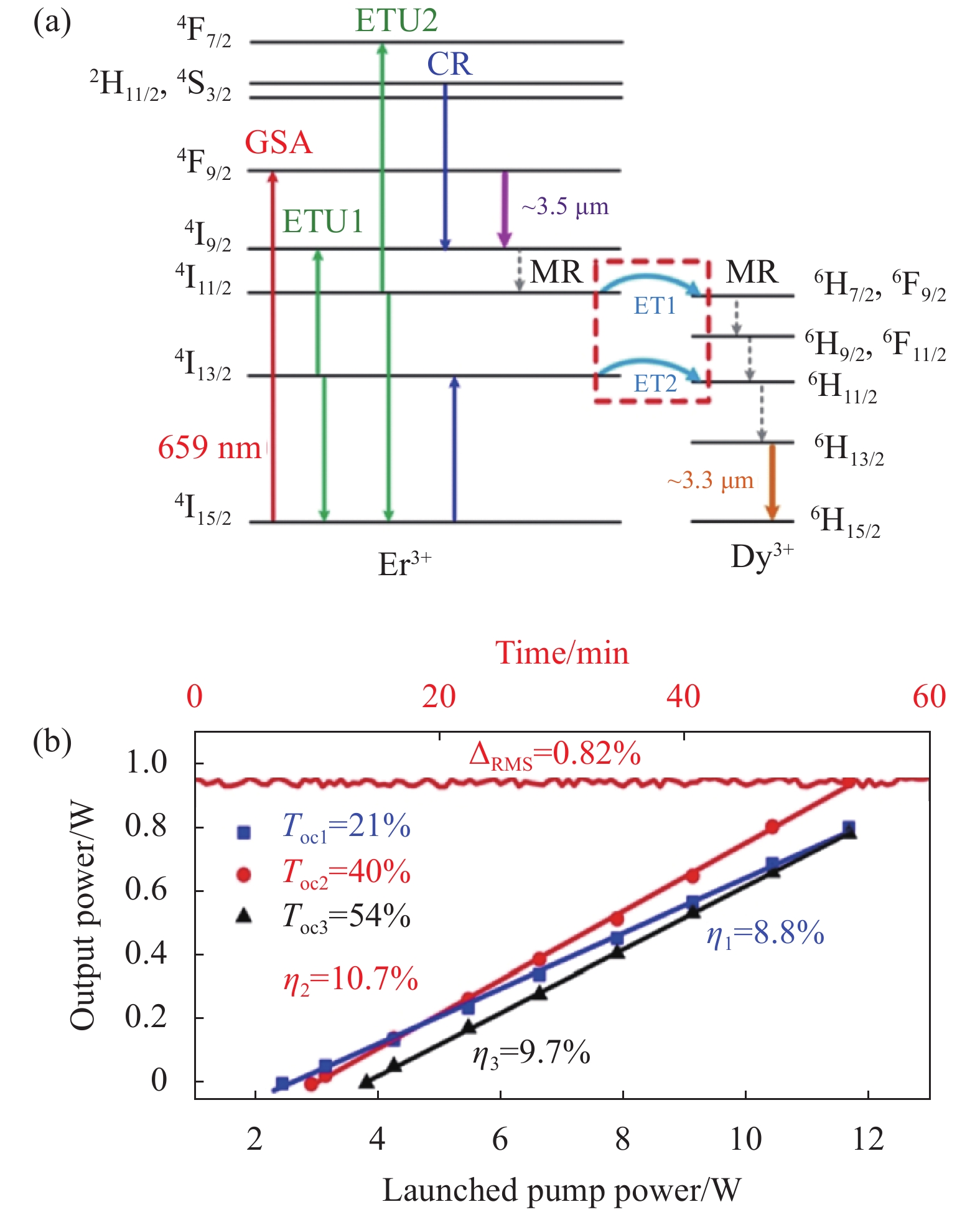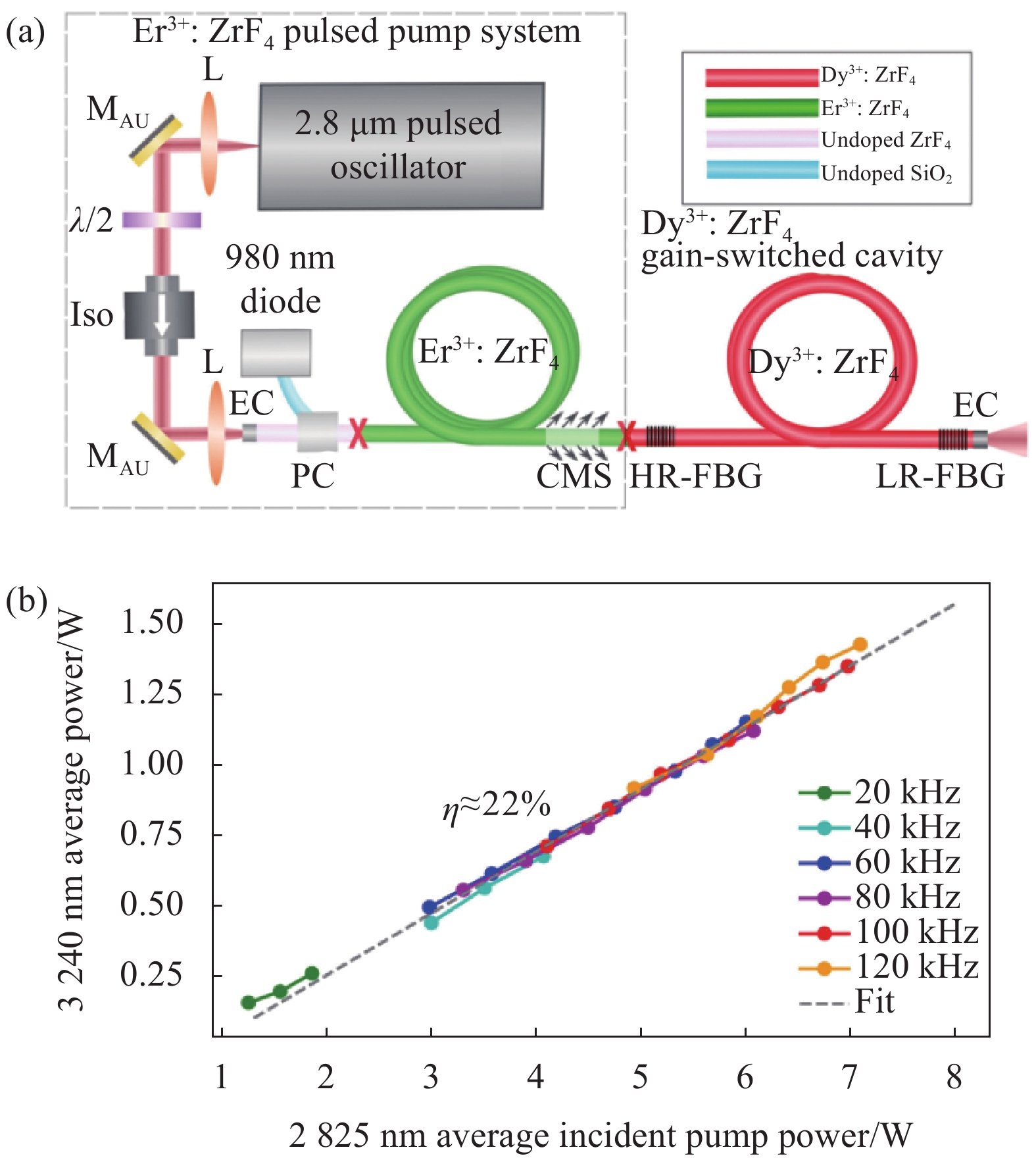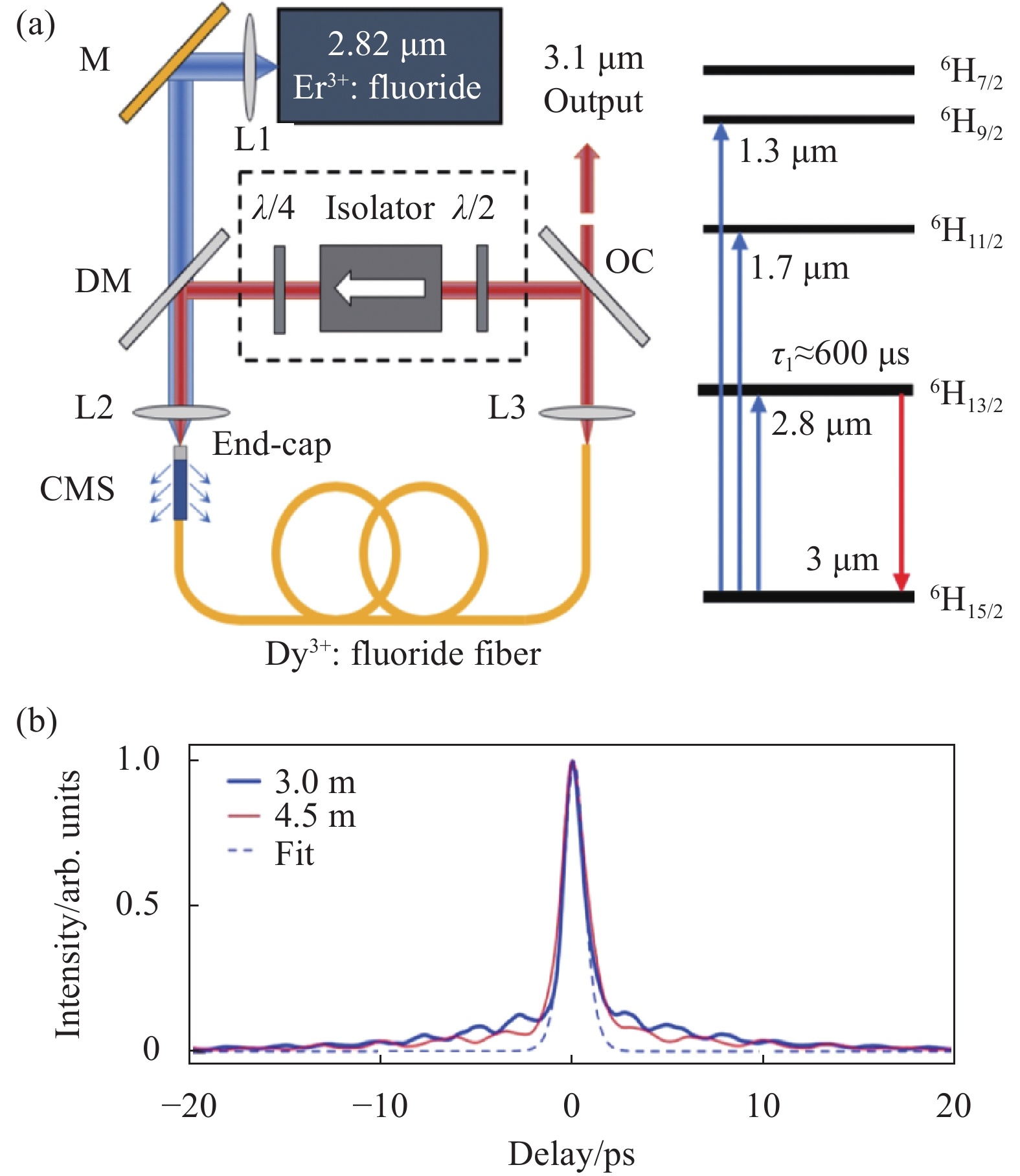-
中红外波段中,3~5 μm是一个极特殊的窗口,它不仅覆盖着众多分子与原子的本征吸收峰,同时还是大气透明窗口之一[1-2]。因此,工作在此波段的激光器在气体探测、材料加工、生物医疗、军事对抗以及遥感等各个领域都具有广阔的应用前景[3-4]。相较于功率较低且工艺要求高的量子级联激光器[5]、体积大且光束质量差的固体激光器以及设计复杂且需要昂贵非线性晶体的光参量激光器等[6],光纤激光器[7]具有光束质量好、易于小型化集成、散热性好、转化效率高、鲁棒性好等优点,在中红外激光领域脱颖而出,成为激光领域的前沿研究热点,并在近些年取得了一系列的突破[8-10]。
目前,在光纤激光器中,产生3~5 μm激光的方法主要有以下四种:(1)基于掺稀土离子光纤的直接激射法[11],即利用掺杂离子在特定能级间的跃迁,辐射3~5 μm激光。(2)基于气体填充光纤的直接激射法[12],即通过N2O、HBr、CO2等气体填充空心石英光纤,利用气体的能级跃迁实现3~5 μm的激光输出。(3)拉曼孤子自频移[13],利用光纤中的拉曼效应实现脉冲内拉曼散射和波长连续红移,进而实现该波段内的波长调谐输出。(4)超连续谱[14],基于光纤中的色散和自相位调制、交叉相位调制等各种非线性效应的共同作用产生超连续谱以实现覆盖3~5 μm波段的激光输出。对于气体填充的中红外光纤激光器,相关成果在近两年才有所报道,相关的研究还不够深入。对于基于超连续谱和孤子自频移效应的光纤激光器,它们通常由不同输出波长的稀土离子掺杂光纤激光器抽运。因此,直接激射稀土离子掺杂光纤是获得3~5 μm波段光纤激光的基本途径。
由于氟化物光纤和中红外器件制备工艺的不完善,相较于发展成熟的近红外波段,3~5 μm波段的稀土离子掺杂光纤激光器整体发展较为滞后。针对此现状,文中将从掺稀土离子氟化物光纤出发,对该方向的研究进展进行系统梳理和分析,分别讨论在连续波(CW)和脉冲状态下工作的中红外光纤激光器发展历程,最后对掺稀土离子中红外光纤激光器的发展趋势进行了展望。
-
由于石英材料具有较高的声子能量(1100 cm−1),石英光纤无法实现波长大于2.2 μm激光的低损耗传输。另一方面,较高的声子能量还会加速长波跃迁猝灭,抑制激光激射,因此,石英光纤不适用于制作波长超过2.2 μm的光纤激光器。为了获得更长波长的中红外光纤激光,采用声子能量较低的碲酸盐(典型组分:75 mol.% TeO2, 20 mol.% ZnO, 5 mol.% Na2O)(800 cm−1)、氟化物(ZBLAN,典型组分:53 mol.% ZrF4,20 mol.% BaF2, 4 mol.% LaF3, 4 mol.% AlF3, 20 mol.% NaF)(580 cm−1)和硫化物(典型组分为As-S、As-Se等)(~300 cm−1)作为光纤基质材料具备更大的潜力。其中,硫化物玻璃成纤后难以同时兼顾高掺杂浓度和低传输损耗,而碲化物光纤中氢氧根含量有待进一步降低。因此,目前基于这两种基质的稀土掺杂光纤激光器尚处于理论探索阶段,还鲜有实验报道。而以氟化物玻璃作为基质的ZBLAN光纤(580 cm−1)以及InF3光纤(510 cm−1)具有较低的声子能量,在2.5~5 μm波段仍保持着较低的损耗。与此同时,氟化物材料具有优良的稀土溶解度,可以实现更高浓度的稀土离子掺杂,现已成为3~5 μm光纤激光器的最佳稀土掺杂基质。因此,开发高质量掺杂氟化物玻璃是实现3~5 μm波段光纤激光器的关键一步。
在3~5 μm波段,常用于激光产生的增益稀土离子主要有Dy3+、Er3+和Ho3+,它们的不同能级跃迁过程分别对应不同波长的辐射带,其受激发射截面和能级跃迁过程见图1。由图可见,这三种离子的辐射带几乎可以覆盖整个3~4.5 μm的波长区间[15-20],虽然也存在稀土离子的辐射带处于4.5~5 μm波段,如铽离子(Tb3+)的7F5→7F6跃迁过程(对应辐射波长:~4.7 μm),但这种元素还未能实现在拉制光纤中的掺杂[21],因此,在文中不做探讨。
如图1所示,掺Er3+氟化物光纤中,更高能级的4F9/2→4I9/2跃迁在~3.5 μm具有强辐射带[22]。在掺Ho3+氟化物光纤中,5I5→5I6是已知对应输出波长最长的跃迁过程,其辐射波长为3.9 μm[23]。此外,掺Ho3+氟化物光纤中的5S2→5F5跃迁可以实现3.22 μm的激光激射[24]。掺Dy3+氟化物玻璃中,6H13/2→6H15/2这一跃迁过程所对应的辐射带几乎可以覆盖2.5~3.4 μm[25-28]。对于掺Dy3+氟化物玻璃中6H11/2→6H13/2的跃迁过程,理论上可以实现4.3 μm的激光辐射,但目前国际上还未能在光纤中实现激光输出。
-
高功率连续中红外光纤激光器在工业制造领域如高分子材料加工、激光焊接、钻孔和清洗以及生物医学领域,如组织汽化和消融等方面具有重要的应用潜力[29]。自掺Er3+氟化物光纤实现3.5 μm连续激光输出以来[22],3 μm以上波段的中红外光纤激光器经历了30余年的发展,开发的基于稀土离子掺杂氟化物光纤的连续中红外光纤激光器取得了一系列的重大突破,表1列举了近些年报道的3~5 μm连续稀土离子掺杂光纤激光器的相关结果,可见,掺Dy3+的ZrF4、掺Er3+的ZrF4和掺Ho3+的InF3光纤都表现出了优异的激光发射潜力。分别在~3.2 μm、~3.5 μm和~3.9 μm波段实现了10.1 W[28]、15 W[33]和200 mW[37]的输出功率。
Ion λpump/μm λoutput/μm Poutput/W η Year Reference Dy3+ 0.8 3.02 0.105 18.5% 2020 [26] Dy3+/Tm3+ 0.8 3.23 0.012 0.3% 2019 [27] Dy3+ 2.8 3.24 10.1 58% 2019 [28] Er3+ 0.98+1.9 3.5 0.26 25.4% 2014 [30] Er3+ 0.98+1.9 3.55 5.6 26.4% 2017 [31] Er3+ 0.655+1.981 3.5 1.72 31.5% 2021 [32] Er3+ 0.98+1.9 3.55 14.9 17.2% 2022 [33] Er3+/Dy3+ 0.976 3.27 0.26 5.73% 2021 [25] Er3+/Dy3+ 0.659 3.4 0.8 8.8% 2022 [34] Ho3+ 1.15 3.002 0.77 12.4% 2011 [35] Ho3+ 1.15 2.955-3.021 0.52 - 2012 [36] Ho3+ 0.888 3.92 0.200 10% 2018 [37] Table 1. 3-5 μm continuous wave fiber laser doped with different rare earth ions
-
如图1所示,掺Dy3+氟化物玻璃中,6H13/2→6H15/2这一跃迁过程所对应的辐射带具有较大的带宽,几乎可以覆盖3~3.4 μm的波长区间。2016年,澳大利亚麦考瑞大学的S. D. Jackson团队利用~2.8 μm光纤激光器直接泵浦掺Dy3+: ZBLAN光纤,激发Dy3+离子6H13/2→6H15/2的跃迁过程,产生3.04 μm的激光输出,斜率效率高达51%,通过增加掺Dy3+: ZBLAN的光纤长度,最终率先实现3.26 μm的激光输出[38];同年,该团队利用该方案进一步实现了2.95~3.35 μm波长连续调谐[39]。2018年,该团队又获得了瓦级的3.15 μm激光输出,实现了目前中红外波段最高的斜率效率(73%)[40];随后,加拿大拉瓦尔大学V. Fortin等人采用同样的泵浦方式,搭建了全光纤系统,最终实现了10.1 W的3.24 μm激光输出,这是Dy3+离子掺杂3~3.4 μm光纤激光器所实现的最高功率水平[28]。然而,这种带内泵浦方式具有固有的缺陷,无法实现整个辐射带内的激光输出。2018年,S. D. Jackson团队又利用~1.7 μm激光泵浦掺Dy3+: ZBLAN光纤,在3.1 μm波长附近,实现了600 nm宽带调谐的激光输出[41]。2022年,笔者课题组使用自制的1.69 μm高功率随机拉曼光纤激光器作为泵浦,采用刻线式衍射光栅作为波长选择和输出耦合器,最终实现了2.710~3.415 μm范围内的波长调谐输出[42],其实验装置如图2所示。这是迄今为止稀土掺杂光纤激光器实现的最宽的波长调谐范围。

Figure 2. (a) Experimental setup of the Dy-doped ZrF4 fiber laser pumped at 1.69 μm; (b) Tunable laser output spectrum[42]
-
1991年,德国不伦瑞克工业大学H. Tobben等人采用655 nm激光泵浦掺Er3+: ZBLAN光纤,首次实现了数毫瓦级 3.5 μm的激光输出。受激光亚稳态能级4I11/2和4I13/2较长寿命的影响,655 nm泵浦光难以保持高效的离子循环。在之后将近20年的时间里,掺Er3+: ZBLAN光纤的拉制技术和掺杂水平已经有了质的提升,但限制~3.5 μm激光高效激射的主要原因——离子数瓶颈问题仍未被有效地解决。直到2014年,阿德莱德大学O. Henderson-Sapir团队提出采用985 nm和1 973 nm双波长级联的方式泵浦,在室温下实现了260 mW的~3.5 μm激光输出。该团队搭建了如图3(a)所示的双波长级联泵浦掺Er3+: ZBLAN光纤激光器,有效地解决了离子数的瓶颈问题[30]。该系统中,985 nm的泵浦光为4I11/2能级提供离子,1 973 nm泵浦光用于将离子进一步抽运到上能级,从而实现离子在4F9/2与4I11/2能级间的高效循环,该方案的转化效率达到了16%[30]。这项极具里程碑意义的研究推动了稀土离子掺杂光纤激光器向3 μm以上波段的拓展进程。在此基础上,上海交通大学、加拿大拉瓦尔大学等单位开展了大量的研究[31-32,43-47]。在该波段能级动力学探索方面,O. Henderson-Sapir团队进一步发现了能量转移上转换(ETU)(4I11/2+4F9/2→4I13/2+4S3/2)这一新跃迁过程[44]。随后,拉瓦尔大学F. Maes等人发现了另一个与3.5 μm激光输出紧密关联的跃迁过程:虚拟激发态吸收(VESA)(4F9/2+1 976 nm→4F7/2)[45]。2022年,该团队报道了一种双波长泵浦的3.55 μm连续激光器,输出功率达到了14.9 W,其整体光学效率为17.2%,斜率效率为51.3%,这项工作进一步刷新了该波段光纤激光器的输出功率纪录[33]。同年,笔者课题组采用659 nm红光二极管包层泵浦Er3+/Dy3+共掺ZrF4光纤[34],其系统如图4所示。在该体系中,长寿命的4I11/2和4I13/2态由于能量转移到共掺杂的Dy3+离子和Er3+离子之间的能量转移上转换而迅速减少,从而加速了离子的循环。最终,在室温下实现0.8 W的3.4 μm激光输出,斜率效率达到8.8%。此外,还观察到在3.3 μm和3.5 μm处自由运转的双波长工作状态,产生的总最大功率为0.95 W,斜率效率为10.7%,通过调谐衍射光栅,在3053.9~3695.9 nm范围内实现了连续光谱调谐。这项方案实现了第一个远超3 μm的二极管泵浦掺稀土光纤激光器瓦级输出,为3~5 μm区域中红外激光的产生提供了一个有潜力的新平台。

Figure 3. Schematic diagram of the 985 nm and 1 973 nm dual-wavelength cascaded pumped Er3+ fluoride doped 3.5 μm fiber laser; (b) Tran-sition process of dual wavelength pumping[30]

Figure 4. (a) Energy level diagram of red light LD pumping doped Er3+/Dy3+: ZBLAN fiber; (b) Output power evolutions[34]
-
2011年,笔者课题组与麦考瑞大学S. D. Jackson团队合作,使用长达10 m的低浓度掺Ho3+: ZBLAN光纤作为增益介质,构建了级联跃迁系统,首次在室温条件下实现了>3 μm的瓦级光纤激光输出[35]。随后,该团队通过引入单面刻线式光栅,实现了2.955~3.021 μm波长调谐激光输出[36]。基于Ho3+掺杂氟化物光纤5I5→5I6是掺Ho3+氟化物玻璃中已知对应输出波长最长的跃迁过程,但受限于ZBLAN光纤在3.9 μm以上波段明显提升的损耗以及较大的量子亏损和产热,对于该跃迁过程,一直未能实现室温下的激光产生。直到2018年,拉瓦尔大学F. Maes等人将Ho3+: InF3光纤作为增益介质,搭建了如图5所示的掺Ho3+: InF3光纤激光器,利用InF3光纤更低的声子能量(典型值:509 cm−1),率先实现了室温下的200 mW、3.9 μm激光输出,该系统激光效率约为10%[37]。受泵浦波长和转化效率制约,掺Ho3+光纤激光器的输出功率相对较低,但基于Ho3+掺杂的氟化物光纤所实现的3.9 μm激光输出是目前直接激射稀土离子掺杂光纤实现的最长波长[37]。为了优化3.9 μm掺Ho3+的光纤激光系统,近些年相关研究团队相继提出了一些理论模型[48-49]。2021年,笔者课题组提出一种888 nm与962 nm双波长泵浦掺Ho3+: InF3光纤的3.92 μm激光产生方案,理论仿真结果表明,与单波长泵浦方案相比,962 nm泵源的存在可以有效地降低系统的阈值,提高激光输出,为今后实验系统的设计和优化提供了一种可行的方案[48]。

Figure 5. Schematic diagram of 3.92 μm fiber laser system at room temperature[37]. (a) Experimental setup; (b) Energy level diagram; (c) Output power
近些年,3~5 μm连续光纤激光器的性能取得了很大的提升,其波长覆盖[37]和输出功率[28,33]已经大幅提高。但相对于~2.8 μm连续光纤激光,3~5 μm波段激光器在功率方面仍有很大的提升空间,其中,3.9 μm掺Ho3+光纤激光进一步的功率放大是研究人员面临的一大挑战,探索提高连续波激光器系统效率的新方法仍然是未来的一项艰巨任务。在波长覆盖方面,4~5 μm掺稀土离子光纤激光器的研究仍然是一片空白,因此,进一步优化基于Ho3+光纤的 3.92 μm 激光输出特性以及探究掺Dy3+光纤的 4.3 μm 的激光动力学特性对实现4 μm波段直接激射光纤激光具有重要意义。
-
根据脉冲持续时间的不同,脉冲激光器被分为短脉冲激光器和超短脉冲激光器两大类。3~5 μm波段短脉冲是指时域持续时间在ns~µs量级的脉冲,在国防领域、医学领域如高效组织消融/切割以及工业领域如特殊材料加工等方面具有重要作用。目前,实现短脉冲输出的主要途径有调Q和增益调制两大类。超短脉冲是指时域持续时间在fs~ps量级的脉冲,中红外超短脉冲激光是当前国际前沿研究热点,在遥感、高次谐波产生以及超快分子成像等领域具有重要的应用前景[29],产生超短脉冲的主要技术手段是锁模。下面将分别对3~5 μm波段短脉冲和超短脉冲的稀土离子掺杂氟化物光纤激光器的发展情况进行介绍。
-
3~5 μm波段脉冲激光是激光领域的一项前沿技术,2.8 μm波段脉冲光纤激光器的飞速发展[8-9],为3~5 μm波段短脉冲光纤激光器的产生创造了契机,这一领域也取得了一系列的技术突破。表2列举了近年3~5 μm稀土离子掺杂短脉冲光纤激光器的相关成果。
Ion λoutput/μm Mechanism Pulse
durationRepetition
ratePulse
energyYear Ref. Dy3+ 2.81-3.03 Q-switching 1.25 μs 50-123 kHz 0.9 μJ 2020 [50] Dy3+ 3.76-3.34 0.46 μs 125 kHz 0.85 μJ 2022 [51] Er3+ 3.47 0.5-1.1 μs 5-100 kHz 7.8 μJ 2018 [52] Er3+ 3.4-3.7 1.18 μs 71.43 kHz 7.54 μJ 2019 [53] Dy3+ 3.24 Gain-
switching300-800 ns 20-120 kHz 19.3 μJ 2020 [54] Er3+ 3.55 30-50 ns 12-20 kHz 6.5 μJ 2018 [55] Er3+ 3.46 1.6-3.2 μs 100 kHz 10.4 μJ 2019 [56] Er3+ 3.4-3.7 1.02 μs 50 kHz 5.29 μJ 2020 [57] Dy3+ 3.1 Mode-
locking0.83 ps 60 MHz 4.8 nJ 2018 [58] Dy3+ 2.97-3.3 33 ps 44.5 MHz 2.7 nJ 2018 [59] Er3+ 3.49 - 28.91 MHz 1.38 nJ 2018 [60] Er3+ 3.47 53 ps 36.23 MHz 1.38 nJ 2020 [61] Er3+ 3.54 0.58 ps 68 MHz 3.2 nJ 2021 [62] Table 2. 3-5 μm pulsed fiber lasers doped with different rare earth ions
-
调Q(损耗)技术是通过在谐振腔内加入调Q器件,周期性地调节腔内的Q值,在短时间内实现能量的释放,从而产生调Q脉冲。
在掺Dy3+氟化物光纤中,2020年,笔者所在的团队将Fe3O4纳米颗粒沉积在金镜上作为被动调Q器件[50],将该器件插入可调谐的掺Dy3+: ZBLAN光纤激光器中,在2812.4~3031.6 nm的可调谐范围内获得了稳定的调Q脉冲,最大输出功率达到了111.0 mW。2022年,采用自制的1.69 μm高功率随机拉曼光纤激光泵浦包含InAs可饱和吸收体和刻线式衍射光栅的掺Dy3+: ZBLAN谐振腔,可以在2.775~3.320 μm/2.765~3.338 μm实现稳定的调Q输出,这是迄今为止稀土掺杂光纤脉冲激光器实现的最大波长调谐范围[51]。
在掺Er3+氟化物光纤中,2018年,澳大利亚阿德莱德大学N. Bawden等使用声光调制器作为调Q器件,采用级联双波长泵浦方案,在掺Er3+: ZBLAN光纤中实现了平均功率高达350 mW的3.47 μm调Q脉冲输出[52,63]。在被动调Q方面,2018年,上海交通大学Z. P. Qin等人利用黑磷和ZnO颗粒这两种可饱和吸收体,结合双波长级联泵浦方案(970 nm+1 973 nm),在掺Er3+: ZBLAN光纤激光器中实现了平均功率120 mW的3.462 μm的被动调Q脉冲[60,64]。同年,笔者课题组使用976 nm和1 981 nm激光器作为泵浦[53],基于Fe2+: ZnSe晶体作为被动调Q器件,采用平面光栅作为调谐器件,搭建了如图6所示的激光系统。在3478.0 nm的调谐波长处,实现了平均功率为583.7 mW的调Q脉冲输出,脉冲能量为7.54 μJ,斜率效率为15.2%,脉宽和重复频率分别为1.18 μs和71.43 kHz。通过转动光栅,实现了3407.2~3701.1 nm的连续调谐,这项工作实现是第一个在3.4 μm以上波段可调谐的稀土掺杂脉冲光纤激光器。

Figure 6. (a) Experimental setup of the Fe2+: ZnSe crystal-based Q-switched Er3+: ZBLAN fiber laser; (b) Average output power and wave-length tunability[53]
在Ho3+掺杂调Q光纤激光器方面,笔者课题组做了大量的工作,2013年,课题组在掺Ho3+光纤激光器中获得了覆盖2.95~3.031 μm的主动调Q脉冲[65]。2015年,报道了波长可调谐的被动调Q掺Ho3+光纤激光器,激光器的波长调谐范围为2.919~3.004 μm[66]。但这些工作都是基于掺Ho3+氟化物光纤中(5I6→5I7)的跃迁(对应辐射中心波长:2.940 μm)。对于长波区间~3.2 μm和~3.9 μm对应的两个跃迁过程(5S2→5F5)和(5I5→5I6),由于近些年一直无法实现激光的高效激射,还难以用于调Q脉冲的产生。
-
增益调制技术通过主动地调节激光器的增益,实现微秒量级脉冲的输出,在稀土离子掺杂光纤激光器中,通常采用脉冲泵浦方式对激光器增益进行调制。
2018年,加拿大拉瓦尔大学F. Jobin等人报告了第一台基于双波长泵浦的3.5 μm增益调制光纤激光器,通过脉冲宽度为几十纳秒的1 976 nm主动调Q激光器和976 nm激光二极管泵浦5 m的掺杂浓度为1.0 mol.%的Er3+: ZBLAN光纤,获得了峰值功率高达204 W、脉宽为30 ns、重复频率为15 kHz的3.552 μm脉冲输出[55]。次年,笔者所在团队选择具有微秒级宽度的1 950 nm被动调Q光纤激光器系统和976 nm连续波激光二极管,泵浦3.2 m的掺杂浓度为1.5 mol.%的Er3+: ZBLAN光纤,在3.46 μm处实现最大平均功率为1.04 W的脉冲激光输出,斜率效率为24.6%,相应的重复频率、脉冲能量、峰值功率和脉冲持续时间分别为100 kHz、10.4 μJ、6.46 W和1.61 μs,并且通过控制1 950 nm的脉冲激光器,获得了55~120 kHz的同步增益调制脉冲[56]。2020年,笔者课题组利用976 nm和1 981 nm连续波激光器作为泵浦,并采用1 981 nm脉冲激光器对输出进行调制,泵浦3.2 m的掺杂浓度为1.5 mol.%的Er3+: ZBLAN光纤,并采用划线式衍射光栅,获得了3397.1~3690.2 nm(~293 nm)的调谐脉冲输出,在3450.5 nm处的最大平均功率为264.5 mW[57]。2020年,拉瓦尔大学F. Jobin等人报道了一种掺Dy3+增益调制的光纤激光器。其系统见图7,采用99.5%高反和65%低反FBG构造谐振腔,并由2.8 μm Er3+: ZrF4脉冲振荡器作为泵浦,产生了平均功率高达1.4 W、脉冲能量达到19 µJ的3.24 μm激光输出,这项工作刷新了该波段脉冲激光器的输出功率记录[54]。

Figure 7. (a) Experimental setup of the gain-switched Dy3+-doped fiber laser at 3.24 µm; (b) Output power[54]
综上所述,随着中红外增益调制、调Q技术以及相关器件的快速发展,3~5 μm短脉冲光纤激光器已经取得了很大的技术突破,然而,在稳定性、峰值功率和脉冲能量等指标的进一步提升上还有很长的路要走。在波长覆盖方面,3.2 μm掺Ho3+(5S2→5F5)和~3.9 μm掺Ho3+(5I5→5I6)氟化物光纤激光器目前仍处于连续激光性能的探索与提升阶段,还无法用于有效的短脉冲激光产生。
-
随着中红外锁模相关器件以及技术的日渐成熟以及超快分子成像、强场光物理等相关技术领域对中红外超短脉冲需求的不断扩大,中红外波段锁模光纤激光器在近些年经历了快速发展,2022年,笔者课题组对此进行了详细的综述报道[20]。对于3~5 μm波段,现行的锁模方法包括如下三种:
(1)基于材料可饱和吸收体锁模(MSA);
(2)基于非线性偏振旋转锁模(NPR);
(3)基于频移反馈锁模(FSF)。
但如表2中所示,3~5 μm波段锁模激光器相关报道较少。这里针对基于上述三种方法锁模的代表性结果进行展示。
2018年,上海交通大学Z. P. Qin等人基于MSA锁模技术,利用黑磷作为可饱和吸收材料,在掺Er3+:ZBLAN光纤激光器中,率先实现了大于3 μm的锁模脉冲输出,其工作波长和信噪比分别为3.49 μm和54 dB[60]。2019年,米兰理工大学Y. C. Wang等搭建了如图8所示的基于NPR锁模的掺Dy3+: ZBLAN环形振荡器[58],最终在3.05 μm、3.08 μm以及3.18 μm均获得了孤子锁模脉冲。麦考瑞大学S. D. Jackson等人将FSF锁模技术用于3~5 μm波段中红外皮秒脉冲产生,使用声光可调谐滤波器,在2.97~3.3 μm可调谐的掺Dy3+: ZBLAN激光器中产生了能量高达2.7 nJ的33 ps脉冲[59]。随后,澳大利亚阿德莱德大学O. Hender-son-Sapir等人利用FSF机制产生了3.4~3.612 µm的53 ps脉冲[61],这是目前实现的最长波长的稀土离子掺杂光纤锁模激光。

Figure 8. Dy3+: ZBLAN ring oscillator with NPR mode-locked[58]. (a) Sche-matic diagram of the cavity and energy level of the ring fiber laser; (b) Pulse autocorrelation trace
近些年,3~5 μm波段超短脉冲光纤激光器实现了从无到有的突破,但目前实现的锁模脉冲最长波长仅为3.61 μm[61]。此外,锁模脉冲性能,包括脉宽压缩、输出功率的提升、向长波长的拓展等方面仍然存在着诸多的问题需要解决和研究。
-
近年来,随着氟化物光纤拉制和掺杂技术的逐步发展与成熟以及泵浦方式的优化与创新,基于稀土离子掺杂的中红外光纤激光器取得了长足的进步。文中分别从连续激光器和脉冲激光器两个方面回顾了近些年报道的工作在3~5 μm 波段的稀土离子掺杂中红外光纤激光器。并总结出如下发展趋势:
(1)输出功率进一步提升
近些年,3 μm以上连续光纤激光器已经实现了15 W的输出功率。但相对于~2.8 μm光纤激光器,该波段激光输出功率仍有很大的提升空间。在未来的研究中,可以通过进一步优化泵浦结构、优化氟化物光纤的制备工艺,优化光纤熔接技术和光纤无源器件如光纤光栅和光纤端帽的性能来进一步提升输出功率至数十瓦甚至上百瓦。
(2)波长进一步向长波拓展
对于稀土掺杂连续激光器,目前波长输出记录为3.92 μm,且自2018年来并未能实现进一步的突破,>4 μm稀土离子掺杂光纤激光领域仍然是一片空白。在未来的研究中,可以对Dy3+中6H11/2→6H13/2的4.3 μm跃迁过程进行进一步的发掘与研究。另一方面,可以通过发展新的掺杂离子如Tb3+,进一步拓展输出波长。
(3)全光纤化
毫无疑问,全光纤化结构是光纤激光系统的发展趋势,在3~5 μm波段,由于光纤功能器件的缺乏以及光纤处理技术的不完善,当前,3~5 μm波段光纤激光器整体全光纤化水平较低。因此,在未来的研究中,应加速开发中红外激光产生所亟须的有源和无源光纤功能器件。
可以预见,在不远的将来,高性能、全光纤3~5 μm掺稀土离子中红外激光器将从实验室走向诸多实用领域,推动工业、医疗、国防等相关领域的技术发展与进步。
Research progress in 3-5 μm rare earth ion doped mid-infrared fiber lasers (invited)
doi: 10.3788/IRLA20230215
- Received Date: 2023-04-11
- Rev Recd Date: 2023-05-05
- Publish Date: 2023-05-25
-
Key words:
- mid-infrared laser /
- fluoroindate fiber /
- rare earth ion /
- continuous wave laser /
- pulsed laser
Abstract:



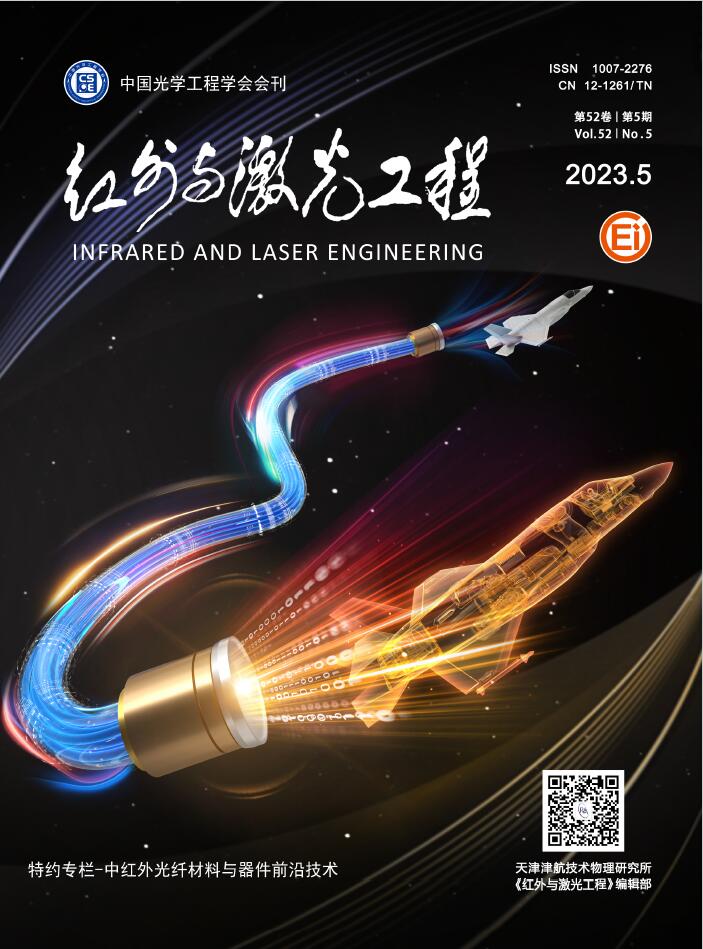







 DownLoad:
DownLoad:
